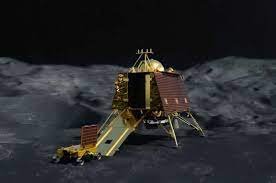Chandrayaan-3 Lander and Rover: Exploring India’s Lunar Ambitions
India’s Chandrayaan-3 mission, named after its predecessors Chandrayaan-1 and Chandrayaan-2, is poised to mark another significant milestone in the country’s lunar exploration efforts. This mission focuses on deploying a lander and rover on the moon’s surface, continuing India’s exploration of the lunar terrain. Let’s delve into the details of this exciting venture.

Why this News is Important
Advancing India’s Space Endeavors
The Chandrayaan-3 mission is vital as it underscores India’s continued commitment to space exploration. In a rapidly evolving global space industry, India has been consistently striving to establish its presence among the elite spacefaring nations.
Building on Past Achievements
This mission is crucial for building upon the success of Chandrayaan-2, which included an orbiter, lander (Vikram), and rover (Pragyan). Although Vikram’s attempt to soft-land on the moon’s surface faced challenges, the orbiter continues to send valuable data. Chandrayaan-3 aims to correct past shortcomings and achieve a successful lunar landing.
Historical Context
To understand the significance of Chandrayaan-3, it’s essential to consider India’s lunar exploration history. India’s first lunar mission, Chandrayaan-1, launched in 2008, made a significant discovery of water molecules on the moon’s surface. Chandrayaan-2, launched in 2019, aimed to explore the south polar region, but the Vikram lander’s unsuccessful landing overshadowed its achievements.
Key Takeaways from “Chandrayaan-3 Lander and Rover”
| Serial Number | Key Takeaway |
|---|---|
| 1 | Chandrayaan-3 is India’s third lunar exploration mission, focusing on deploying a lander and rover on the moon. |
| 2 | This mission aims to build on the success of Chandrayaan-2 and rectify past challenges for a successful lunar landing. |
| 3 | Chandrayaan-3 is crucial for advancing India’s position in space exploration and contributing to scientific knowledge about the moon. |
| 4 | India’s previous lunar missions, Chandrayaan-1 and Chandrayaan-2, paved the way for Chandrayaan-3’s ambitions. |
| 5 | The mission has the potential to make significant scientific discoveries about the moon’s geology and surface conditions. |
Important FAQs for Students from this News
Q: What is Chandrayaan-3, and how does it differ from Chandrayaan-2?
A: Chandrayaan-3 is India’s third lunar mission, primarily focused on deploying a lander and rover on the moon’s surface. It differs from Chandrayaan-2 in that it aims to correct the shortcomings of the Vikram lander’s soft-landing attempt during Chandrayaan-2.
Q: What are the scientific objectives of Chandrayaan-3?
A: Chandrayaan-3 aims to make significant scientific discoveries about the moon’s geology, surface conditions, and possibly its history. It carries advanced scientific instruments for this purpose.
Q: What were the achievements of Chandrayaan-1 and Chandrayaan-2?
A: Chandrayaan-1 made a groundbreaking discovery of water molecules on the moon’s surface. Chandrayaan-2, despite Vikram’s landing challenges, continues to send valuable data from its orbiter.
Q: How does Chandrayaan-3 contribute to India’s space endeavors?
A: Chandrayaan-3 underscores India’s commitment to space exploration, advancing its position among spacefaring nations and showcasing technological prowess.
Q: What is the historical context of India’s lunar exploration missions?
A: India’s lunar exploration history began with Chandrayaan-1 in 2008, followed by Chandrayaan-2 in 2019. Chandrayaan-3 builds upon these missions.
Some Important Current Affairs Links


















